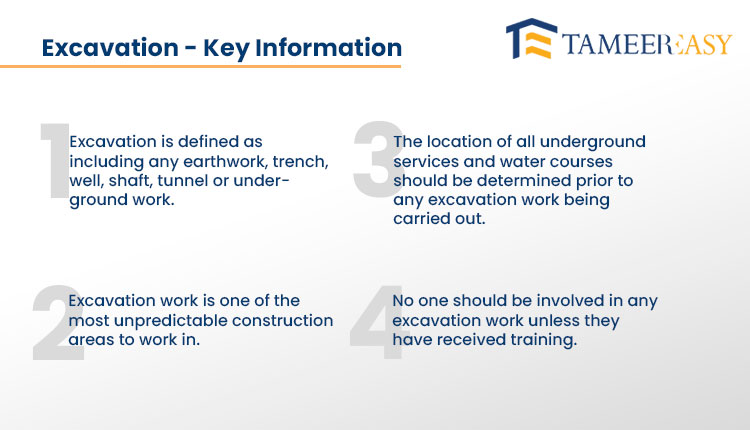Have you ever seen ancient buildings like Badshahi Mosque Lahore or Red Fort Delhi and wondered how these structures are standing firm for such a long time? You may have also wished for your houses that can last longer and where you never face issues like the settlement.
Visit TameerEasy Store to Purchase Quality Construction Items
Do you know that compaction, excavation, and foundation are essential processes that play a crucial role in building strength? In this article, we will talk about the excavation process, its different types, mechanism and how it plays a role in construction. So scroll down the page to find all the updated information.

What is Excavation?
Before starting the construction of the house, we build the foundation according to the design. We dig the ground up to a few feet to strengthen these foundations. How is this digging performed, and what techniques are used to complete this process? The overall knowledge and mechanism to do this are called excavation; we will discuss it in depth here.
The Need for Excavation Work
Generally, we need excavation work around three to four times during construction. Here are they:
- First of all, excavation is performed to erect the foundations.
- Secondly, if you are building an underground water tank or septic tank in your house, you have to excavate at that particular place.
- Besides this, excavation is done during the basement construction or installation of sewerage lines or any other cable.
Is Excavation Necessary During the Construction?
Yes, excavation in construction is highly essential, without which the concept of strength and durability remains incomplete. Through excavation work, you find the hard surface on which you start building the foundation, and in this way, you do not face the issues like settlement (زمین کا بیٹھ جانا). The whole weight and load of the building are ultimately transferred to the surface, and you will never want to put it on a loose surface.
How is Excavation Work Performed?
In all types of excavation, we use a standard procedure that remains the same in different styles. The general rule is that we dig the natural surface per our needs. By natural surface, we mean that a few plots have made-up levels like there is garbage or filling buried underneath them. Besides this, they could also have organic and inorganic materials under them, and we can never erect the foundation over them.
So while starting the excavation work, you must clean any garbage, filling or other inorganic or organic material. After that, we start the excavation, and the depth and width are kept as per the requirements.


How to Decide the Depth and Width of Excavation Work?
Generally, the excavation depth is kept around 2 to 2 ½ feet in a double-storey house. In contrast, the width is decided as per the design of the foundation and house. It is also mandatory to keep three inches of space on either side of the width, which is further filled with mud (روڑی).
Similarly, excavating an underground water tank requires digging only a little deep. The main point you must keep in mind is to keep the distance of the tank from the street to 4 feet so that your neighbours can also get the same space. In this way, the risk of sliding at the excavated place can be avoided in the future.
On the other hand, for the basement, cables or sewerage lines, do the excavation as needed at the time. There are a few critical preventive measures which you must take while doing this.
Important Precautionary Measures to Take During Excavation
- Before excavating, check for any wire or pipe under the surface. If there are any, try to avoid them using hidden services.
- Never leave the deep excavation open like the basement for a long time. Instead, try to complete it as soon as possible.
- Before starting the basement excavation, take care of your neighbours by taking preventive measures. So they do not face any issues during this process.
- Never start excavation work during rainy weather.
Top Excavation Methods
- Excavation for walls is performed manually.
- For basement excavation, we use excavators.
- We do the excavation manually after the whole compaction process is completed for sewerage lines or maintenance holes.
Closing Remarks
We are hopeful that up till now, you have come to know about all the crucial aspects of excavation. We have tried to tell you all the complex steps involved in this process, and you can now start excavation with much ease. If you still think that you have any questions related to excavation or any other construction process, you can contact us through our website, tameereasy.com.







